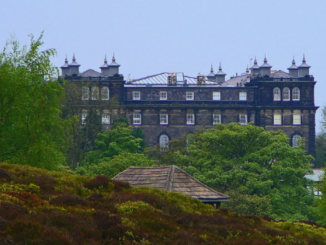At the end of a Goldfinger car chase through the Furka Pass, Bond and Tilly Masterson stand beside a white Ford Mustang whose tyres have just been shredded by the optional extendable tyre shredder of an Aston Martin DB5. Good Samaritan OO7, part way through introducing himself as Bond, James Bo…,” is interrupted by Ms Masterson who insists he takes her to the nearest garage as quickly as possible. The next township of any size is Andermatt where Mr Bond and Miss Tillerson will have lingered. Photographic evidence of their 1954 road trip shows my grandparent’s Ford Prefect took a left and headed north along the valley of the river Reuse to Altdorf, home of another famous adventurer, without a Walther PPK or a collapsable vanity case snipers rifle, William Tell.
Here the Reuss, troublesome during spring thaws, is enclosed in a two-and-a-half-mile-long straight as cross-bow shot canal which reaches the southernmost extreme of doglegged Lake Lucerne. For context, Lake Lucerne is about 21 miles long whereas our own Ullswater measures seven and a bit.

© Always Worth Saying 2022, Going Postal
At Altdorf, my grandparents paused to photograph the William Tell memorial. The bronze statue is by sculptor Richard Kissling and depicts the heroic Tell with his crossbow behind his shoulders and his son by his side. Inaugurated in 1895, it sits at the base of a much older tower. At 18m high, the top is reached via 86 stairs. Dating back to the Middle Ages it is thought to have been built in the 13th century and is decorated around the outside with freezes depicting Swiss history.
A souvenir stall can be seen to the left in the old photo. In the modern day, the shops behind are a Blumen bakery and a branch of the Union Bank of Switzerland.
Reference to our easy-to-understand Swiss railway timetable come map come journey planner suggests Altdorf doesn’t have a station. However it does, sandwiched between Erstfeld and Flüelen.
Following last week’s run along the Rhone Valley on the Furka line, those who prefer to travel by train would have to change at Andermatt for the 15-minute trip to Goschenen (after a nine-minute wait). From there it’s a three-minute wait for the hourly service to Lucerne, spelt Luzern, reached two hours later (I think). By road the route hugs the lake all the way but by train it only goes as far as Ingenbohl which isn’t on the planner either. There it heads inland taking advantage of the Laurerzersee and Zugersee valleys before approaching Lucerne from due east. In doing so the rails pass other stations not shown on our comprehensive Swiss railways Swiss Army knife-style map/timetable/planner. I’m sure it’s me that’s doing something wrong.
Just after Ersteld, the Gothard Base Tunnel joins the line. At 35.5 miles, the Gothard is the world’s longest and deepest railway tunnel and connects Italy, via Bellinzona, Locarno and Lugano to Lucerne, Zurich and northern Europe.
Continuing by road, the next photograph is poor but easy to locate. It is taken from a bridge over the Gruonbach River. Slightly later we look back towards Altdorf. To the right is Gitschen which rises to 8244ft.
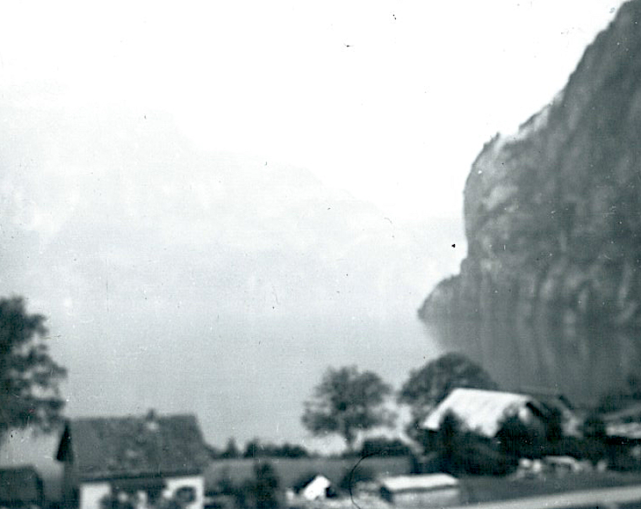
© Always Worth Saying 2022, Going Postal
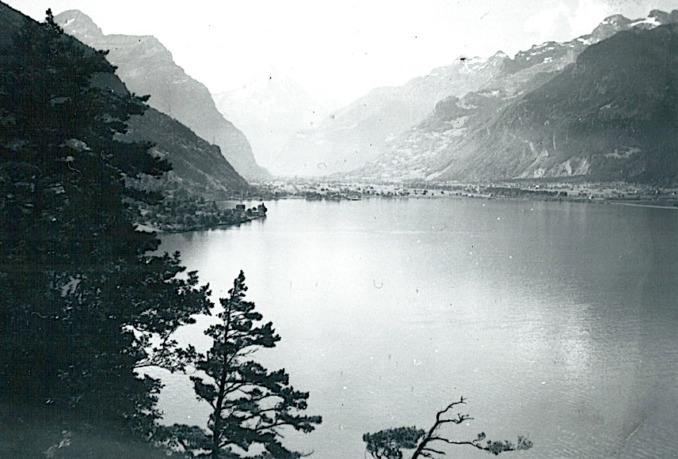
© Always Worth Saying 2022, Going Postal
Having left the railway line, the next port of call is Gersau. Before the road was built the town was so remote that at one time it was its own independent small state within the canton of Schwyz, reachable only by boat or across a treacherous mountain pass. Created in 1390, the residents of Geresau village bought themselves free from the rule of the bailiffs of Lucerne and from then on exercised their own rights themselves. If Going Postal was a place…
At an elevation of 1,427ft and nestled in the south face of Mount Rigi, Gersau has a population of 2,300, up from 1,890 during my grandparent’s 1950s visit. Known as the Lucerne Riviera, the town has been a well-known health and vacation resort since 1860 and contains a significant number of hotels and guest houses. In 1891 the queen regent of the Netherlands and the young queen Wilhelmina left The Hague by train for a four to six weeks stay there. In 1966 The People carried an advert for 10-day holidays with 7 nights at the resort priced from 24 gns. A 1983 advertising feature in the Illustrated London News told of 14 hotels with 700 beds.
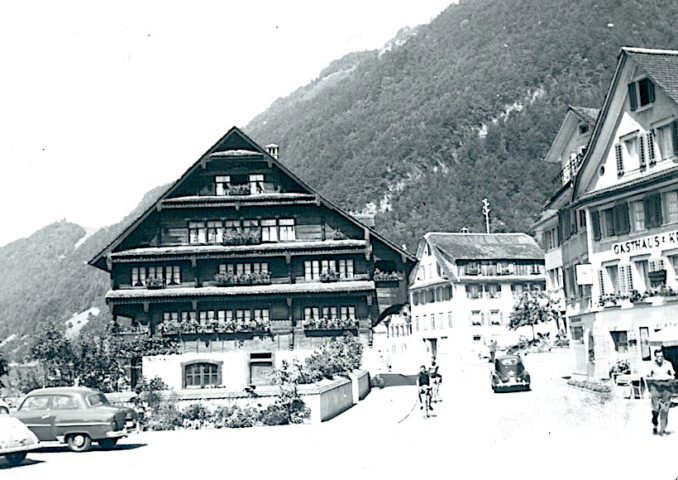
© Always Worth Saying 2022, Going Postal
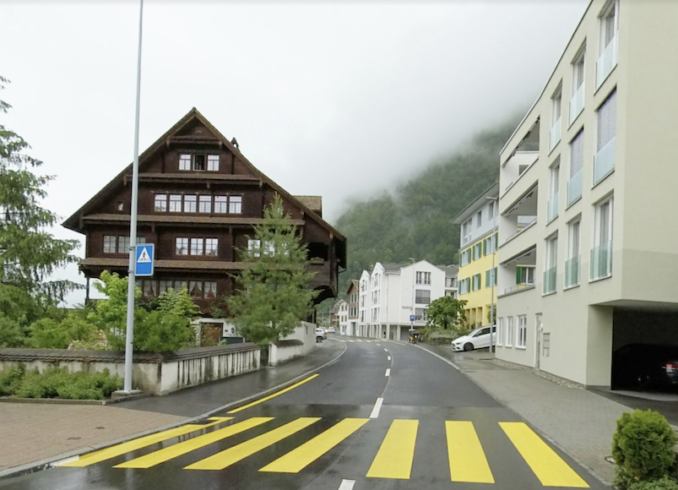
© Google Street View 2022, Google
The top photograph appears to be captioned ‘Achaet, Gersau’ as though somewhere my family stayed. To the right sits Gasthaus K… A walled garden sits before the Achaet and in front of that a car park. At first I assumed the photo to be of the Gasthaus Tubli, a similar building but, upon further inspection, pointing in the wrong direction. Because of the hill, we must be facing west. That diagonal line across the hillside, as if an ancient landslide, is distinctive and helpfully findable.
A walk around the township revealed the correct property is still there and is pictured above on a lakeside road addressed as Seestrasse 41, apparently now a private residence or apartments. The walled garden has survived, as has the car park. The thoroughfare is now garish with intrusive road furniture. The guesthouse and other neighbouring buildings have been replaced by slab-sided modern structures of about the same height. I suppose it could be worse. Have a look around via this link.
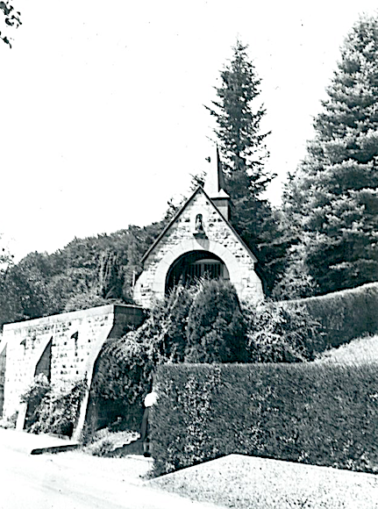
© Always Worth Saying 2022, Going Postal
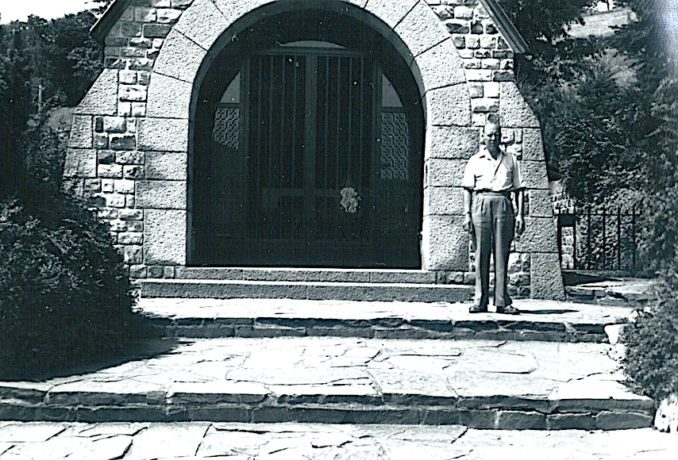
© Always Worth Saying 2022, Going Postal
Further along the lake close to Kussnacht, we reach the Astrid Memorial Chapel built on the site of a fatal car accident which took the life of Queen Astrid of Belgium. The wife of King Leopold III, son of the notorious Leopold II who used the Congo as a personal fiefdom, Astrid was killed when their car left the road, hit a tree and landed in the lake one fateful August day in 1935. The chapel can still be seen from the road.
If Astrid’s name rings a bell, she was multiply related to the Scandanavian aristocracy who peppered our companion piece Mystery Album’s between the wars Grand Tour of the Baltic.
All of which brings us to Lucerne.

© Always Worth Saying 2022, Going Postal
You can still stand on the same spot seventy years later with the jetty pier looking remarkably similar and in remarkably good repair. The white wooden posts are well-preserved too. Behind the photographer sits Lucerne railway station, a horrible concrete box replacing a fine 1896 cupola-topped building which burned down in 1971. Completed in 1991, the awful Bahnhalle by Ammann and Baumann’s Santiago Calatrava leads to a much more pleasing trainshed of five glass arched roofs beneath which sit seven island platforms allowing for fourteen terminating tracks.
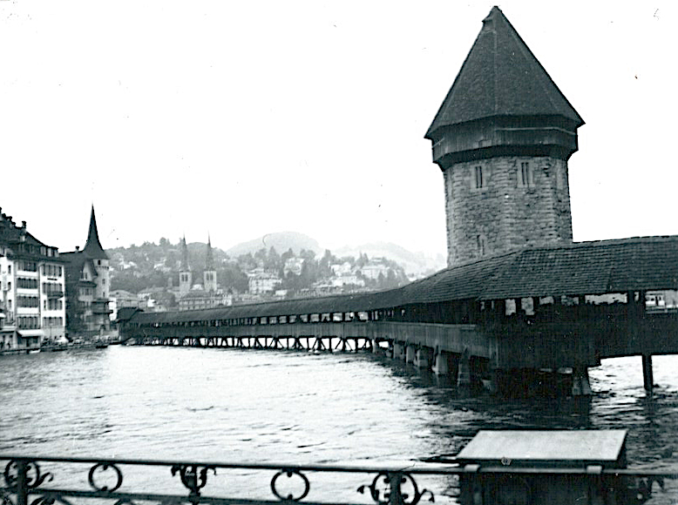
© Always Worth Saying 2022, Going Postal
Judging by the railings and the angle to the shorelines, this image was taken from the Rathaussteg footbridge which neighbours the photographed wooden Kapellbrucke, or Chapel Bridge. The chapel in question is the St Peters at the other side of the river Reuss. The bridge contains a number of paintings dating back to the 17th century and is the world’s oldest surviving truss bridge, the oldest wooden covered bridge in Europe and, then and now, one of Switzerland’s main tourist attractions.
Originally built in 1365, the bridge linked the old and new towns and provided fortification against attack from the south.
From this fine and well-preserved vantage, may I take the opportunity to wish Puffins a merry and spiritual Christmas.
© Always Worth Saying 2022


